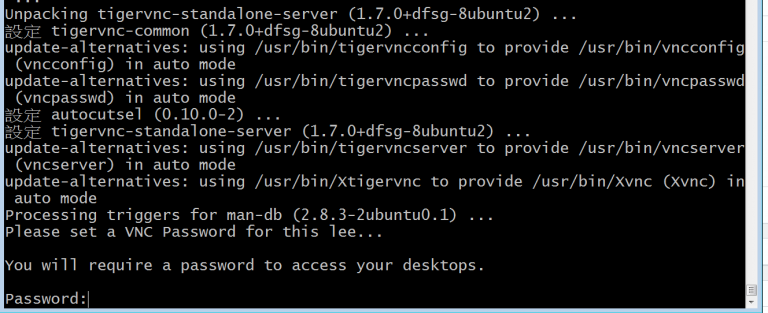
- #TIGERVNC SERVER UBUNTU INSTALL#
- #TIGERVNC SERVER UBUNTU SOFTWARE#
- #TIGERVNC SERVER UBUNTU PASSWORD#
You can start a VNC session by using the vncserver command as follows:.
#TIGERVNC SERVER UBUNTU PASSWORD#
(Technically you don’t need to set up a new VNC password if you’ve previously created one, but doing this each time ensures you remember what it is!)Note that while you’re typing your password on Linux, you will not see any feedback at all (no asterisks). Note that VNC passwords must be 8 characters or less – if you type a longer password, everything after character eight is ignored.
#TIGERVNC SERVER UBUNTU SOFTWARE#
The VNC software unfortunately does not appear to be compatible with other Java engines. The following software is required – it works on both Windows and macOS: VNC sessions will not start if your account is over the disk quota. The ECE Linux Lab systems have VNC software installed. The Home Plan - has some other limits - but may do what you need.VNC ( Virtual Network Computing) allows graphical programs to be run remotely with the ability to reconnect to that session should the network connection fail. You then use the systemtray to login/activate your realvnc home account. Then give you an VNC icon in the systemtray.

#TIGERVNC SERVER UBUNTU INSTALL#
With the realvnc stuff, you download the package for your system, install it, then run the 'vncserver' program while on an X session, it will start up some setup wizard i recall. I have used the service for years now, and i still have to stumble around to find those pages. The hardest part of RealVNC - is finding the right download for the free plan! :)īut i cant recall how i made the 'free' plan account - it was something that came with the Raspberry Pi Install i was using ages ago. Others? - Not sure - hard to keep track of them all.Īs I said - i tend to just use realvnc - because most of the time i am remoting in from my Mobile phone. Tightvnc - i THINK can only do a virtual session. RealVNC = Shares local desktop (by default) and Can from what i read of its docs - support a virtual session. X11vnc = shares the local desktop to the remote pc. Some VNC servers can use one mode or the other. this is the ONLY way (i think) that vnc server works when being ran from windows. Or VNC can 'share' the currently running Local Desktop that you are seeing currently. (you would have a separate X session in that vnc client window) To see it on the local machine, you would log into your Normal Desktop, and run a vnc client and connect to localhost, or your machine ip. it is running on a 'X session' that you can ONLY see via a vnc client. I use the term 'local' to mean the pc you are sitting at.Ī 'virtual desktop session' mode - which is NOT seen on the local monitor. The thing to remeber about vnc - it can work in two modes.


I use RealVNC and its free home use plan on my Ubuntu Desktop.īut other vnc servers can work fine for a local desktop.


 0 kommentar(er)
0 kommentar(er)
